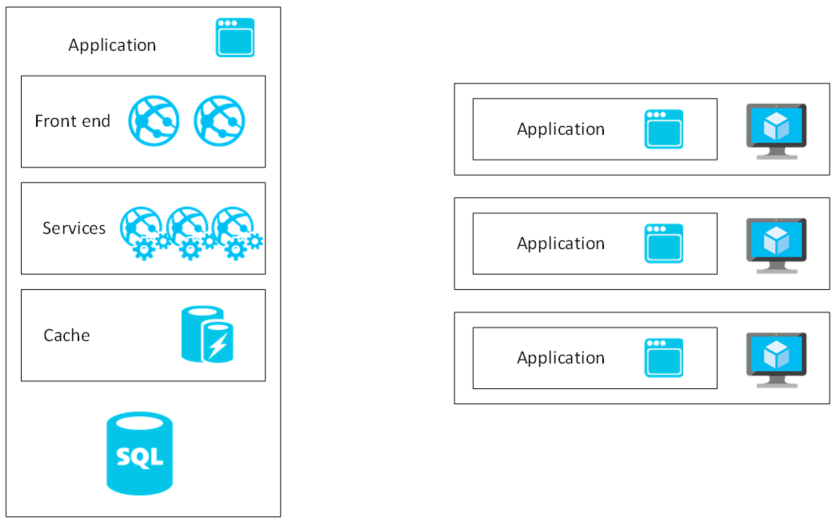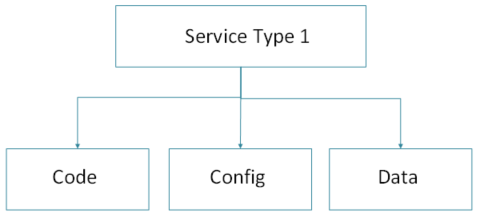
An enterprise application platform can be defined as a suite of products and services that enables development and management of enterprise applications. This platform should be responsible of abstracting complexities related to application development such as diversity of hosting environments, network connectivity, deployment workflows, etc. In a traditional world, applications are monolithic by nature. A monolithic application is composed of many components grouped into multiple tiers bundled together into a single deployable unit. Each tier here can be developed using a specific technology and will have the ability to scale independently. Monolithic application usually persists data in one common data store.

Although a monolithic architecture logically simplifies the application, it introduces many challenges as the number of applications in your enterprise increases. Following are few issues with a monolithic design
- Scalability – The unit of scale is scoped to a tier. It is not possible to scale bundled within an application tier without scaling the whole tier. This introduces massive resource wastage resulting in increase in operational expense.
- Reuse and maintenance – The components within an application tier cannot be consumed outside the tier unless exposed as contracts. This forces development teams to replicate code which becomes very difficult to maintain.
- Updates – As the whole application is one unit of deployment, updating a component will require updating the whole application which may cause downtime thereby affecting the availability of the application.
- Low deployment density – The compute, storage and network requirements of an application, as a bundled deployable unit may not match the infrastructure capabilities of the hosting machine (VM). This may lead to wastage of shortage of resources.
- Decentralized management – Due to the redundancy of components across applications, supporting, monitoring and troubleshooting becomes expensive overheads.
- Data store bottlenecks – If there are multiple components accessing the data store, it becomes the single point of failure. This forces the data store to be highly available.
- Cloud unsuitable – The hardware dependency of this architecture to ensure availability doesn’t work well with cloud hosting platforms where designing for failure is a core principle.
A solution to this problem is an Application platform based on Microservices architecture. Microservice architecture is a software architecture pattern where applications are composed of small, independent services which can be aggregated using communication channels to achieve an end to end business use case. The services are decoupled from one another in terms of the execution space in which they operate. Each of these services will have the capability to be scaled, tested and maintained separately.

Microsoft Azure Service Fabric
Service Fabric is a distributed application platform that makes it easy to package, deploy, and manage scalable and reliable Microservices. Following are few advantages of a Service Fabric which makes it the ideal platform to build a Microservice based Application Platform
- Highly scalable – Every service can be scaled without affecting other services. Service Fabric will support scaling based on VM scale sets which means that these services will have the ability to be auto-scales based on CPU consumption, memory usage, etc.
- Updates – Services can be updated separately and different versions of a service can be co-deployed to support backward compatibility. Service Fabric also supports automatic rollback during updates to ensure consistency of an application deployment.
- State redundancy – For state full Microservices, the state can be stored alongside compute for a service. If there are multiple instances of a service running, the state will be replicated for every instance. Service Fabric takes care of replicating the state changes through the stores.
- Centralized management – The service can be centrally managed, monitored and diagnosed outside application boundaries.
- High density deployment – Service Fabric supports high density deployment on a virtual machine cluster while ensuring even utilization of resources and distribution of work load.
- Automatic fault tolerance – The cluster manager of Service Fabric ensures failover and resource balancing in case of a hardware failure. This ensures that your services are cloud ready.
- Heterogeneous hosting platforms – Service Fabric supports hosting your Microservices across Azure, AWS, On premises or any other datacenter. Cluster manager is capable of managing service deployments with instances spanning multiple datacenters at a time. Apart from Windows, Service Fabric also supports Linux as a host operating system for your micro services.
- Technology agnostic – Services can be written in any programming language and deployed as executables or hosted within containers. Service Fabric also supports a native Java SDK for Java developers.
Programming models
Service Fabric supports the following four programming models for developing your service:
- Guest Container – Services packaged into Windows or Linux containers managed by Docker.
- Guest executables – Services can be packaged as guest executables which are arbitrary executables, written in any language.
- Reliable Services – An application development framework with fully supported application lifecycle management. Reliable services can be used to develop stateful as well as stateless services and supports transactions.
- Reliable Actors – A virtual actor based development framework with built-in state management and communication management capabilities. Actor programming model is single threaded and is ideal for hyper scale out scenarios (1000s or instances)
More about Service Fabric programming models can be found here
Service Type
A service type in Service Fabric consists of three components

Code package defines an entry point to the service. This can be an executable or a dynamic linked library. Config package specifies the service configuration for your services and the data package holds static resources like images. Each package can be independently versioned. Service fabric supports upgrade of each of these packages separately. Allocation of a service in a cluster and reallocation of a service on failure are responsibilities of Service Fabric cluster manager. For stateful services, Service Fabric also takes care of replicating the state across multiple instances of a service.
Application Type
A Service Fabric application type is composed of one or more service types.

An application type is a declarative template for creating an application. Service fabric uses application types for packaging, deployment and versioning Microservices.
State stores – Reliable collections
Reliable Collections are highly available, scalable and high performance state store which can be used to store states alongside compute for Microservices. The replication of state and persistence of state on secondary storage is taken care of by the Service Fabric framework. A noticeable difference between Reliable Collections and other high-availability state store (such as cache, tables, queues, etc.) is that the state is kept locally in the service hosting instance while also being made highly available by means of replication. Reliable collections also support transactions and are asynchronous by nature while offering strong consistency.
More about reliable collection can be found here
Management
Service Fabric offers extensive health monitoring capabilities with built-in health status for clusters and services and custom app health reporting. Services are continuously monitored for real-time alerting on problems in production. Performance monitoring overheads are diluted with rich performance metrics for actors and services. Service Fabric analytics is capable of providing repair suggestion thereby supporting preventive healing of services. Custom ETW logs can also be captured for guest executables to ensure centralized logging for all your services. Apart from support for Microsoft tools such as Windows Azure Diagnostics, Operational Insights, Windows Event Viewer and Visual studio diagnostics events viewer, Service Fabric also supports easy integration with third party tools like Kibana and Elastic search as monitoring dashboards.
Conclusion and considerations
Microsoft Service Fabric is potential platform capable of hosting enterprise grade Microservices. Following are few considerations to be aware of while using Service Fabric as your Microservice hosting platform.
- Choosing a programming model is critical for optimizing the management of Microservices hosted on Service Fabric. Reliable services and Reliable actors are more thickly integrated with the Service Fabric cluster manager compared to guest containers and guest executables.
- The support for containers on Service Fabric is in an evolving stage. While Windows containers and Hyper-V containers are on the release roadmap, Service Fabric only supports Linux containers as of today.
- The only two native SDKs supported by Service fabric as of today is based on .net and Java.
